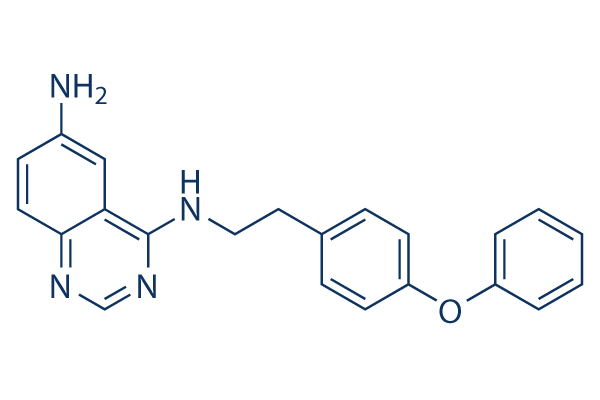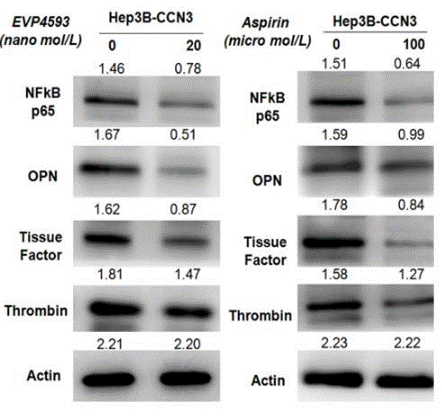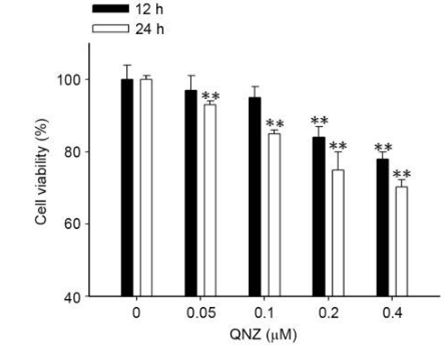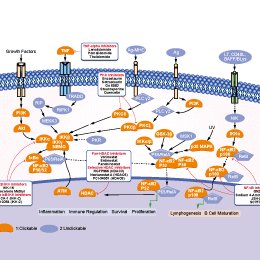
- Bioactive Compounds
- By Signaling Pathways
- PI3K/Akt/mTOR
- Epigenetics
- Methylation
- Immunology & Inflammation
- Protein Tyrosine Kinase
- Angiogenesis
- Apoptosis
- Autophagy
- ER stress & UPR
- JAK/STAT
- MAPK
- Cytoskeletal Signaling
- Cell Cycle
- TGF-beta/Smad
- DNA Damage/DNA Repair
- Compound Libraries
- Popular Compound Libraries
- Customize Library
- Clinical and FDA-approved Related
- Bioactive Compound Libraries
- Inhibitor Related
- Natural Product Related
- Metabolism Related
- Cell Death Related
- By Signaling Pathway
- By Disease
- Anti-infection and Antiviral Related
- Neuronal and Immunology Related
- Fragment and Covalent Related
- FDA-approved Drug Library
- FDA-approved & Passed Phase I Drug Library
- Preclinical/Clinical Compound Library
- Bioactive Compound Library-I
- Bioactive Compound Library-Ⅱ
- Kinase Inhibitor Library
- Express-Pick Library
- Natural Product Library
- Human Endogenous Metabolite Compound Library
- Alkaloid Compound LibraryNew
- Angiogenesis Related compound Library
- Anti-Aging Compound Library
- Anti-alzheimer Disease Compound Library
- Antibiotics compound Library
- Anti-cancer Compound Library
- Anti-cancer Compound Library-Ⅱ
- Anti-cancer Metabolism Compound Library
- Anti-Cardiovascular Disease Compound Library
- Anti-diabetic Compound Library
- Anti-infection Compound Library
- Antioxidant Compound Library
- Anti-parasitic Compound Library
- Antiviral Compound Library
- Apoptosis Compound Library
- Autophagy Compound Library
- Calcium Channel Blocker LibraryNew
- Cambridge Cancer Compound Library
- Carbohydrate Metabolism Compound LibraryNew
- Cell Cycle compound library
- CNS-Penetrant Compound Library
- Covalent Inhibitor Library
- Cytokine Inhibitor LibraryNew
- Cytoskeletal Signaling Pathway Compound Library
- DNA Damage/DNA Repair compound Library
- Drug-like Compound Library
- Endoplasmic Reticulum Stress Compound Library
- Epigenetics Compound Library
- Exosome Secretion Related Compound LibraryNew
- FDA-approved Anticancer Drug LibraryNew
- Ferroptosis Compound Library
- Flavonoid Compound Library
- Fragment Library
- Glutamine Metabolism Compound Library
- Glycolysis Compound Library
- GPCR Compound Library
- Gut Microbial Metabolite Library
- HIF-1 Signaling Pathway Compound Library
- Highly Selective Inhibitor Library
- Histone modification compound library
- HTS Library for Drug Discovery
- Human Hormone Related Compound LibraryNew
- Human Transcription Factor Compound LibraryNew
- Immunology/Inflammation Compound Library
- Inhibitor Library
- Ion Channel Ligand Library
- JAK/STAT compound library
- Lipid Metabolism Compound LibraryNew
- Macrocyclic Compound Library
- MAPK Inhibitor Library
- Medicine Food Homology Compound Library
- Metabolism Compound Library
- Methylation Compound Library
- Mouse Metabolite Compound LibraryNew
- Natural Organic Compound Library
- Neuronal Signaling Compound Library
- NF-κB Signaling Compound Library
- Nucleoside Analogue Library
- Obesity Compound Library
- Oxidative Stress Compound LibraryNew
- Plant Extract Library
- Phenotypic Screening Library
- PI3K/Akt Inhibitor Library
- Protease Inhibitor Library
- Protein-protein Interaction Inhibitor Library
- Pyroptosis Compound Library
- Small Molecule Immuno-Oncology Compound Library
- Mitochondria-Targeted Compound LibraryNew
- Stem Cell Differentiation Compound LibraryNew
- Stem Cell Signaling Compound Library
- Natural Phenol Compound LibraryNew
- Natural Terpenoid Compound LibraryNew
- TGF-beta/Smad compound library
- Traditional Chinese Medicine Library
- Tyrosine Kinase Inhibitor Library
- Ubiquitination Compound Library
-
Cherry Picking
You can personalize your library with chemicals from within Selleck's inventory. Build the right library for your research endeavors by choosing from compounds in all of our available libraries.
Please contact us at info@selleckchem.com to customize your library.
You could select:
- Antibodies
- Bioreagents
- qPCR
- 2x SYBR Green qPCR Master Mix
- 2x SYBR Green qPCR Master Mix(Low ROX)
- 2x SYBR Green qPCR Master Mix(High ROX)
- Protein Assay
- Protein A/G Magnetic Beads for IP
- Anti-Flag magnetic beads
- Anti-Flag Affinity Gel
- Anti-Myc magnetic beads
- Anti-HA magnetic beads
- Poly DYKDDDDK Tag Peptide lyophilized powder
- Protease Inhibitor Cocktail
- Protease Inhibitor Cocktail (EDTA-Free, 100X in DMSO)
- Phosphatase Inhibitor Cocktail (2 Tubes, 100X)
- Cell Biology
- Cell Counting Kit-8 (CCK-8)
- Animal Experiment
- Mouse Direct PCR Kit (For Genotyping)
- New Products
- Contact Us
research use only
QNZ (EVP4593) NF-κB inhibitor
QNZ (EVP4593) shows potent inhibitory activity toward both NF-κB activation and TNF-α production with IC50 of 11 nM and 7 nM in Jurkat T cells, respectively.

Chemical Structure
Molecular Weight: 356.42
Purity & Quality Control
Batch:
Purity:
99.94%
99.94
Related Products
Signaling Pathway
Cell Culture and Working Concentration
| Cell Lines | Assay Type | Concentration | Incubation Time | Formulation | Activity Description | PMID |
|---|---|---|---|---|---|---|
| Jurkat | Kinase assay | ~10 μM | causes NF-κB Inhibition with EC50 of 9 nM | 21700213 | ||
| Jurkat | Function assay | 3 μM | causes SOC Inhibition | 21700213 | ||
| neurons | Function assay | 300 nM | inhibit store-operated Ca2+ entry | 21700213 | ||
| SK-N-SH | Function assay | 300 nM | inhibits TRPC1-Supported SOC Ca2+ currents | 21700213 | ||
| neurons | Function assay | 300 nM | protect YAC128 MSN from glutamate toxicity | 21700213 | ||
| GABA MS-like neurons | Function assay | 100 nM | rescues abnormal SOC-mediated calcium entry | 27080129 | ||
| GABA MS-like neurons | Function assay | 1000 nM | normalizes the number of lysosomes/autophagosomes | 27080129 | ||
| GABA MS-like neurons | Function assay | 100 nM | rescues aging neurons from cell death | 27080129 | ||
| HepG2 | Function assay | HARVARD: Inhibition of liver stage Plasmodium berghei infection in HepG2 cells, IC50 = 0.012 μM. | 22586124 | |||
| HepG2 | Function assay | 0.1 to 10 uM | 1 hr | Inhibition of TNFalpha-induced NFkappaB (unknown origin)-dependent transcriptional activity expressed in human HepG2 cells at 0.1 to 10 uM incubated for 1 hr prior to TNFalpha induction measured after 6 hrs by dual-luciferase reporter gene assay | 23219854 | |
| Click to View More Cell Line Experimental Data | ||||||
Mechanism of Action
| Targets |
|
|---|
In vitro |
||||
| In vitro | EVP4593 inhibits TNF-a production from murine splenocytes stimulated with LPS with IC50 of 7 nM. [1] EVP4593 (300 nM) entails a significant decrease of amplitude of store-operated currents (approximately by 60%), induced by application of 1 μM thapsigargin in Htt138Q cells, thus prevents abnormal store-operated calcium entry. EVP4593 is able to inhibit the activity of channels containing TRPC1 as one of the subunits, but has no effect on homooligomer channels composed exclusively of TRPC1. [2] QNZ (40 nM) completely abolishes the enhancement of neurite number and length evoked by laminin treatment of the schwann cells. QNZ reduces the neurite length by 61.36% of the schwann cells. QNZ significantly inhibits laminin-induced neurite outgrowth. QNZ also greatly diminishes the neurite elongation after 72 hours culture implying that both initial sprouting and longer term growth and extension seen in response to schwann cells seeded on laminin is mediated by NF-κB. [3] QNZ (10 nM) abolishes LPS-induced up-regulation of CSE expression in rat neutrophil. [4] QNZ (100 nM) blocks the induction effects of GRO/KC on K currents in IB4-negative neurons. [5] |
|||
|---|---|---|---|---|
| Kinase Assay | NF-κB assay | |||
| Human Jurkat T cells are cultured at 37℃ in a 5% CO2 atmosphere in RPMI1640 containing 10% FCS. The cells are plated in 6-well plates (2×106/well) and transiently transfected using the SuperFect Transfection Reagent with 1 μg of pNFκB-Luc. After transfection, the cells are cultured at 37℃ overnight. They are then collected, resuspended in fresh medium, and plated in 96-well plates (2×105/well). EVP4593 is dissolved in DMSO and added at the appropriate concentrations to the 96-well plates containing the cells, and the plates are then incubated at 37℃ for 1 hour. For induction of transcription, 10 ng/mL of PMA and 100 μg/mL of PHA are added to each well, and the cells are incubated for an additional 6 hours at 37℃. The culture media are removed, and cell lysis buffer containing luciferase substrate is added to each well. The each portion is transferred to a black 96-well plate, and then luminescence is immediately measured with a Packard Topcount. The 50% inhibitory concentration (IC50) values are calculated by a nonlinear regression method. | ||||
| Cell Research | Cell lines | Jurkat cells | ||
| Concentrations | IC50 of 11 nM (NF-κB) and 7 nM (TNF-α) | |||
| Incubation Time | 1 h | |||
| Method | Test compounds were dissolved in DMSO and added at the appropriate concentrations to the 96-well plates containing the cells, and the plates were then incubated at 37 C for 1 h |
|||
| Experimental Result Images | Methods | Biomarkers | Images | PMID |
| Western blot | NF-κB p65 / OPN / Tissue factor / Thrombin VEGF / TNF-α / IL-1β / IL-6 / MMP-2 / MMP-9 / NF-κB p65(Ser536) |

|
29061995 | |
| Growth inhibition assay | Cell viability |

|
28693192 | |
In Vivo |
||
| In vivo | EVP4593 (1 mg/kg, i.p.) dose-dependently inhibits carrageenin-induced paw edema in rats. [1] |
|
|---|---|---|
| Animal Research | Animal Models | male SD rats with carrageenin induced paw edema |
| Dosages | 1 mg/kg | |
| Administration | intraperitoneal injection | |
References |
|
Chemical Information
| Molecular Weight | 356.42 | Formula | C22H20N4O |
| CAS No. | 545380-34-5 | SDF | Download SDF |
| Synonyms | N/A | ||
| Smiles | C1=CC=C(C=C1)OC2=CC=C(C=C2)CCNC3=NC=NC4=C3C=C(C=C4)N | ||
Storage and Stability
| Storage (From the date of receipt) | |||
|
In vitro |
DMSO : 7 mg/mL ( (19.63 mM) Moisture-absorbing DMSO reduces solubility. Please use fresh DMSO.) Water : Insoluble Ethanol : Insoluble |
Molecular Weight Calculator |
|
In vivo Add solvents to the product individually and in order. |
In vivo Formulation Calculator |
|||||
Preparing Stock Solutions
Molarity Calculator
In vivo Formulation Calculator (Clear solution)
Step 1: Enter information below (Recommended: An additional animal making an allowance for loss during the experiment)
mg/kg
g
μL
Step 2: Enter the in vivo formulation (This is only the calculator, not formulation. Please contact us first if there is no in vivo formulation at the solubility Section.)
% DMSO
%
% Tween 80
% ddH2O
%DMSO
%
Calculation results:
Working concentration: mg/ml;
Method for preparing DMSO master liquid: mg drug pre-dissolved in μL DMSO ( Master liquid concentration mg/mL, Please contact us first if the concentration exceeds the DMSO solubility of the batch of drug. )
Method for preparing in vivo formulation: Take μL DMSO master liquid, next addμL PEG300, mix and clarify, next addμL Tween 80, mix and clarify, next add μL ddH2O, mix and clarify.
Method for preparing in vivo formulation: Take μL DMSO master liquid, next add μL Corn oil, mix and clarify.
Note: 1. Please make sure the liquid is clear before adding the next solvent.
2. Be sure to add the solvent(s) in order. You must ensure that the solution obtained, in the previous addition, is a clear solution before proceeding to add the next solvent. Physical methods such
as vortex, ultrasound or hot water bath can be used to aid dissolving.
Tech Support
Answers to questions you may have can be found in the inhibitor handling instructions. Topics include how to prepare stock solutions, how to store inhibitors, and issues that need special attention for cell-based assays and animal experiments.
Tel: +1-832-582-8158 Ext:3
If you have any other enquiries, please leave a message.
* Indicates a Required Field






































